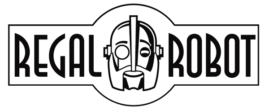We chat with Tom St. Amand as we debut our Prune Face™ Concept Maquette Replica release!
We feel so honored that legendary ILM artist Tom St. Amand has been a part of our latest edition, providing signatures and even hand-drawn sketches for our Prune Face Concept Maquette Replica Editions (Available 1/9/24 at Noon EST). There will be both a Signature Edition and a Legacy Edition, which includes not just a signature but a one of a kind hand drawn sketch by St. Amand as well! Learn more or reserve yours on our Archive Collection page!
Our favorite part of these editions are getting to know the people behind the scenes and sharing their stories and insights with fans. Our company founder, Tom Spina, had an in-depth chat with St. Amand and they discussed his inspirations, his work on Star Wars: Return of the Jedi™ and so much more. Below you’ll find that full conversation, with St. Amand’s responses in BOLD.
Spina – Creature FX in the 70’s and 80’s were an intense explosion of innovation and you were working in the epicenter of it. What was that like?
St. Amand – When I get together with Phil Tippett or Randy Dutra, we sometimes think back on how grateful we were to have gotten into the effects business when we did, where you could work with and build physical props, and work with ‘real’ cameras. I loved the CRAFT of what we did. I thought the invention and use of motion control cameras made a huge difference in the quality of images you could generate. And I thought the work that people like Rick Baker, Chris Walas, and Stan Winston did was state of the art. It still holds up!
You were part of the group that started at the fx house, Cascade, correct? That seems to be a nexus for a lot of the original ILM crew and FX guys.
I was hired at Cascade in 1975 by Bill Hedge who, like many of the other guys there, was a multi-talented effects person who could sculpt, animate, and do camera work.
My time there was very important to me and I learned a lot from everybody. Bill hired me as an ‘assistant model maker.’ That was where I met Phil [Tippett], Jon [Berg], Ken [Ralston], Dave Allen and Dennis Muren. Tom Scherman, Laine Liska, Dave Stipes and Mike Minor were there also. All great guys! Along with Tex Avery, who was a genuinely funny and inventive man. Tex could make anything funny! And he had some great Bob Clampett stories.
We have a common friend in Bob Burns. He and Kathy have been some of the most supportive people for folks who want to make monsters for a living.
Bob and Kathy were wonderful people, very generous with their time and knowledge. I worked on their ‘War of the Worlds’ Halloween show, which was fun. They had an announcer there who would tell the audience what was going to happen. I loved that at one point, when he was grabbed by a tentacle, he took the time to say “He’s got me, ladies and gentlemen! The monster’s got me!” Bob knew Ed Wood and had a few great stories about him.
You started at ILM when Star Wars was already a phenomenon. How did you feel about Star Wars at the time?
I was hired to work on The Empire Strikes Back by Jon Berg and Phil Tippett. Since I loved the original Star Wars, I was thrilled to move up to Marin County and work on the sequel. I had already visited the guys when they were working on the additional Cantina characters for the first film.
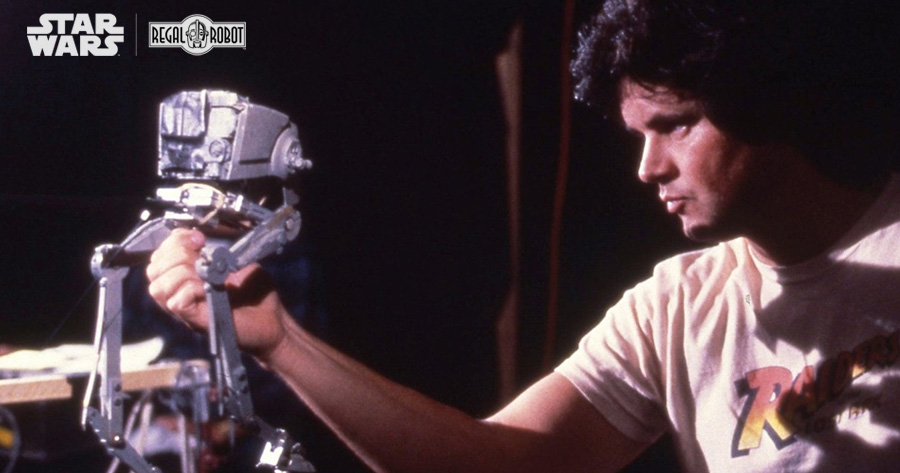
Armature building is a very unique skill set. How did you start?
I always loved the idea of puppet armatures and built my first ones out of wood right after I got out of high school. My first metal ones were made out of brass, since it was easier to cut and machine.
Do you feel there’s anything in your experience, skills or even personality that helped make you a great armature builder?
Thank you for the compliment. While I started building armatures on my own, I later learned a great deal about their construction from Jon Berg, Dave Allen, and Bill Hedge. Later on, I had a chance to work with Jim Danforth, who also made superb armatures. The fact that I was an animator myself helped guide me towards certain strategies when I was designing and building armatures. One of the things I learned was to design as few restrictions as possible. I also advise anyone who wants to learn how to build them to take their work out for a test drive around the block. Do some stop motion with whatever you build and try to learn from it. Try acting out a scene yourself, if possible, and see how you move. We used stop watches to time stuff in those days because you couldn’t always count on tracking down good reference.
You seem to do both mechanical and artistic things very well… and also puppetry, stop-motion animating and digital character animating, which are true performance skills. How do you manage that left/right brain balance on all that?
I always drew, from childhood, and was a tremendous fan of Charles Addams work and of Mad Magazine, who had wonderful artists like Jack Davis and Mort Drucker. I loved those Aurora monster kits, and put together many of them. I made my own marionettes and put on puppet shows. I always believed that if you wanted to learn how to do something bad enough, you could. And that if you keep at it, you’ll get better. Working with the Cascade crew was illuminating because each of those guys had multiple skills.
Do you prefer any particular part of the work?
I liked all the aspects of the work, loved building armatures, and frequently – but not always – loved animating puppets. Stop motion was like doing a live performance. On some shots you could do no wrong, and on others you had the ‘Midas touch’ of badness. In addition to technical things going wrong, mainly camera stuff. Shots with multiple characters were the most challenging ones for me. Also, shots where there was no place to put a surface gauge. I also occasionally made molds and ran rubber.
Do you have any other another creative outlets?
Yes, I do oil painting occasionally, both plein air and indoors. I also make my own home-made binders on a variety of artists and subjects.
How’d you get hired for the Return of the Jedi creature shop?
Phil hired me to work in the ROTJ creature shop right after we all finished working on Dragonslayer.
What was the shop like?
The shop was great, kind of like a monster kid’s dream come true. We all knew each other and could joke about Ed Wood films, etc. And we all grew up on the same monster and Harryhausen movies.
Was the crew close?
Yes, the crew was pretty close. We’d hang out together for lunches and talk about stuff. And ILM had these great chili cookoffs, where we’d all meet up at some lake, or at a park. Sometimes we could get ahold of a 16mm print of something and watch it in the screening room. I came up with some of the other maquette character names. One of the ideas I suggested was naming three of them Klatuu, Barada, and Nikto, from the 1951 version of The Day the Earth Stood Still. I’ve forgotten which creatures got assigned which name.
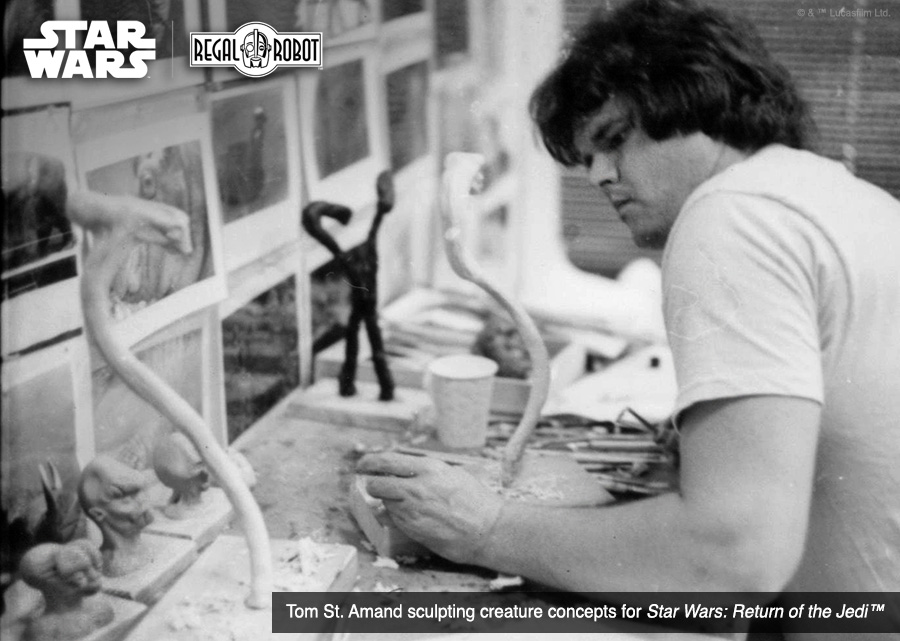
Let’s talk maquettes! What it been like seeing the sculptures and revisiting these sculptures after all these years later?
It’s fun to look at the work 42 years later, kind of like meeting up with an old friend.
What was the maquette process like (broadly)?
We did the work in a newer section of buildings that they had barely finished working on, near the back of ILM that had previously been an empty lot. Jon Berg and Joe Johnston used to fire off rockets back there.
I don’t recall much specific direction from anyone while we worked on the maquettes. Everyone was free to come up with whatever their fancy was.
I occasionally did a rough sketch. I did a sketch of a guy with two snakes growing out from the back of his head. Phil asked if he could use the idea and I said “Sure, go ahead.” He ended up adding it to his Bib Fortuna design. I also worked intuitively, without having a specific reference.
Do you have a favorite creature that didn’t make the cut? (either yours or someone else’s?)
There was a creature that the late Dan Howard designed, that looked like a kind of hybrid human/robot. I thought that one should have made the cut; it was very unique.
Let’s chat about the maquettes you sculpted for the film.
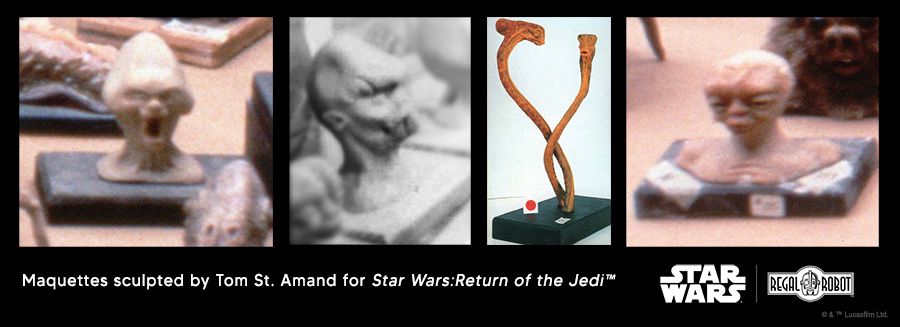
“HAPPY HEAD” (left in the above image) – That’s the Archives’ pet name for this one. The sculpt certainly has a bit of pop. He’s screaming and has that Dwight Frye Renfield neck with the tendons popping. Any design intent here?
‘Happy Head’ probably took a couple of days. I wanted him to look angry. Like a martinet. That was probably the only guiding principle I had. Sometimes you’d start with one idea, and as you sculpted other possibilities presented themselves.
“MYSTERY BUST” (second from left) – It looks to be a brother piece to Happy Head. This particular maquette isn’t in the archives and there are just two photos we have of it! Seems like another small bust alien with a heavy brow. It almost feels a bit 50’s Paul Blaisdell-inspired?
Although I loved and grew up on Paul Blaisdell’s work, I wasn’t thinking of it when I sculpted this guy. Looking at it now, there could have been a bit of gorilla influence, since I was such a big fan of Kong and Mighty Joe Young. Kind of like a man-ape.
“CANE HEADS” – (second from right) these are a really unique design. Why two heads? What took you to that place on these?
I just thought of them in terms of a pair, two of the same species but looking slightly different. Like from different tribes.
So rather than a single two-headed creature, it was two creatures that are intertwined?
Years ago, I saw someone sculpt a version of them with both heads attached to a single body, but when I designed them, I thought of them as two separate bodies, not one. Benign creatures.
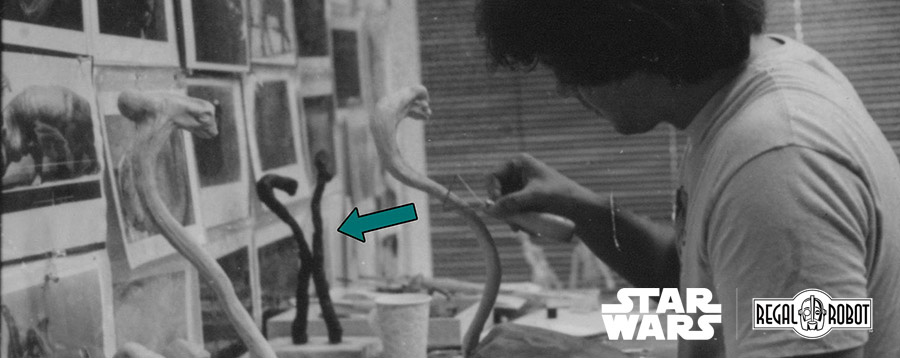
In an old pic of you working on the Cane Heads, is there an all-black version of them I see behind you on the desk?
The story on the black cane heads in the background, which were made in Sculpey, is that I put them into the oven to bake and then forgot to take them out in time! I felt obliged to throw them away and start anew, and I did, but looking back I wish I’d kept the burnt ones!
Oh goodness, that’s every artist’s nightmare! It looks like you stuck pretty closely to your original design when you redid them.
Yes, I felt strongly enough about the design to stick with it for the second version. The first version was probably a better sculpt, technically.
The paint is neat on these. Similar base tones but different accents and spotting. Were Giraffes an inspiration for the paint? If not, what was?
The paint job on them was done by one of the other guys, with me going on to some other task. Maybe Ken or Dave Carson.
“PRUNE FACE” – (right) The Man of the Hour! Was this just a generic alien or was there some intent?
My intention with Prune Face was to design an intelligent, kind-hearted alien. I didn’t think of him as a ‘monster.’ I thought he was more of a misshapen version of a human being. Although some people have drawn comparisons of him to the design of E.T., I never saw any pictures of E.T. until months after I had designed Prune Face, and had in fact finished working in the creature shop.
Dennis Muren pulled me out of the shop to work on E.T., building the puppets for the scenes when the kids ride their bikes in the sky. Inasmuch as I had to sculpt a miniature E.T. to go into the bike basket for Eliot’s bike, ILM sent a request to Amblin for a photograph of the character to work from, since we didn’t have one. They were, understandably, secretive about the design of the character, and sent only a single picture, and not a particularly good one.
So, for those who might have secretly – or not so secretly – wondered, Prune Face was not in the least influenced by the design for E.T.
Who sculpted the full size Prune Face?
I sculpted the full-size Prune Face head, and I also sculpted the hands for him. While I made some alterations to the top and back of the head while I worked on it, I prefer the look of the original maquette. I thought the face of the full size one had a bit more complexity.
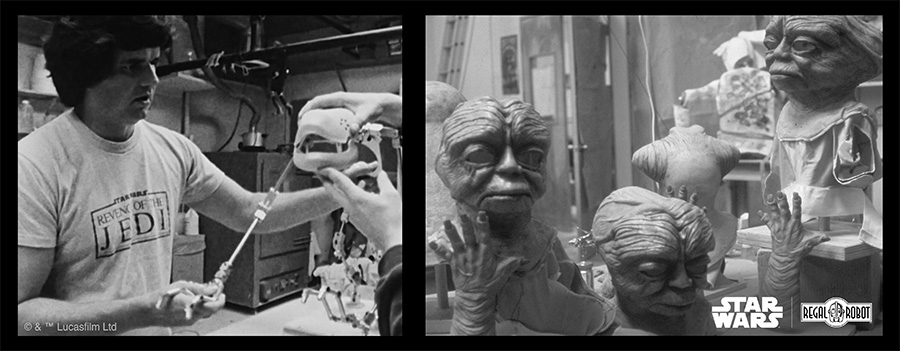
As a kid, I had the Kenner figure and always assumed he was a bad guy from Jabba’s palace, but turns out he was a Rebel. Did you think of him as a bad guy or good guy?
I always thought of him as a good guy. I recall putting a pair of brown, human-looking eyes in the maquette. They were glass doll’s eyes. Not ‘scary monster eyes.’
Thank you for doing the signing for our Prune Face signature edition. You’re now the second artist to join us in creating a Legacy Edition as well, and have done 83 hand-drawn sketches for fans to bring into their homes.
Thank you for inviting me! I wish you guys were around when I was a kid!
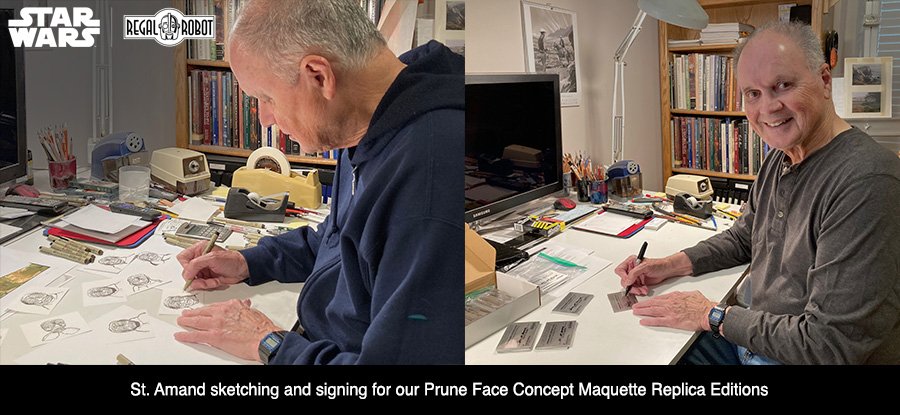
How does it feel knowing collectors want to bring these sculptures into their collections and that they celebrate the work you and others did behind the scenes?
I feel great about your company wanting to bring back versions of these characters for people who may want to own a copy. I talk with friends about how we’d all love to have a casting of one of Ray Harryhausen’s creatures. Especially the Cyclops from 7th Voyage of Sinbad!
—————
What work did you do on Return of the Jedi?
I built the armatures for the Scout Walkers and animated 12 of the shots in that sequence. I also helped to fit the people who played the Ewoks into their costumes.
For the Rancor Pit Monster, I puppeteered the arms while Phil manipulated the head and body, with Dave Sosalla doing the feet. I had built an armature for Rancor when we were considering doing it with stop motion. I was also a puppeteer on the speeder bike sequence. The puppets for that sequence were fashioned over the armatures I had made for the E.T. kids.
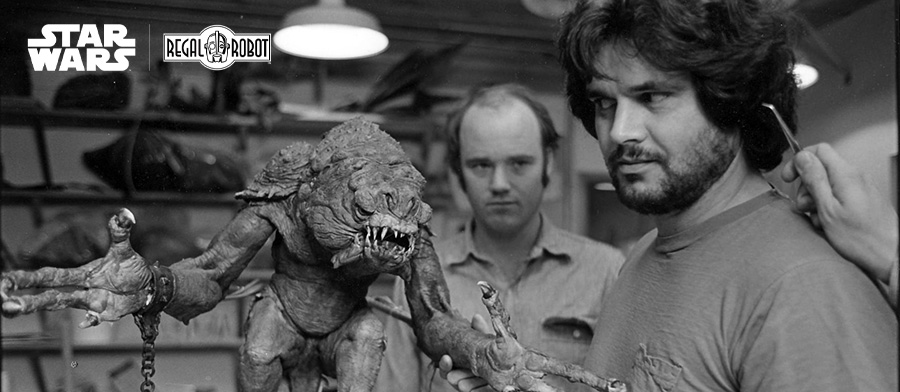
You got to work on the Prequels as well.
I worked as a computer graphics animator on The Phantom Menace and Attack of the Clones. Among other shots I animated, I designed the walk and run cycles for the Kaduus, which were 2-legged camel-like creatures.
For me, working with smaller crews in the old days was much more enjoyable overall. And certainly more personal.
I tend to be more comfortable sculpting big 1:1 monster heads than little sculptures. Do you have a preferred scale?
I believe I preferred working on smaller sculptures rather than life-size.
Do you bring any of the precision you need in machining or armature design to your sculpting process or does that turn off when you’re doing something organic?
I try to bring some kind of precision to almost anything I do. That includes things like drafting, which I had to pick up. The challenge is to craft your intention, no matter how many ‘tries’ it takes.
But Norman Rockwell was quoted as being grateful for what he called the ‘happy accident,’ and I entirely agree with him. Even when animating a shot, you might not want to always strictly follow your plan, because in the process of doing it you may gain some other insight.
What do you think makes a good monster?
Something with humanity. Like the Lon Chaney Jr. Wolfman. Or Karloff’s Frankenstein.
Why do you think movie monsters and practical FX endure?
I believe people will always enjoy fantasy films, along with ‘scary’ films. For me, there’s still some ineffable ‘something’ that seems more real with practical effects rather than strictly computer graphics. My favorite sequences are ones that figure out a way to combine them.
Do you still make art?
I still paint and draw occasionally and I enjoy it. Whatever the source of your inspiration, and whatever the discipline is, you’re still trying to create something unique.
Artists never really retire.
No, they never do. Because however much you’re physically creating, or not creating, you’re always ‘thinking.’
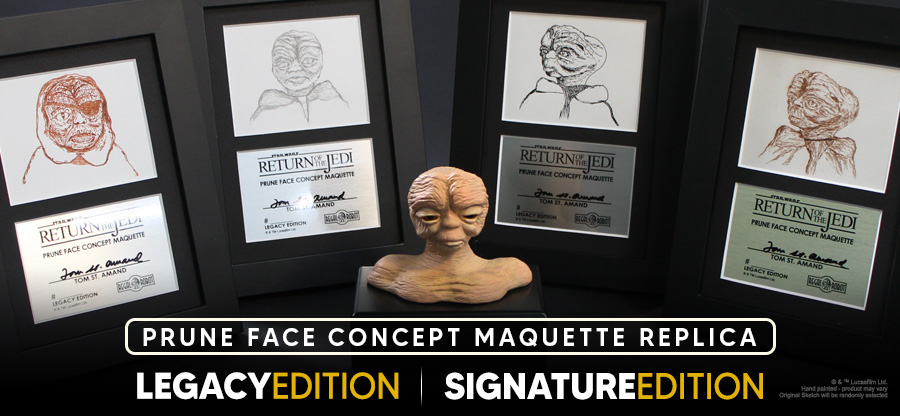
©Lucasfilm LTD.
